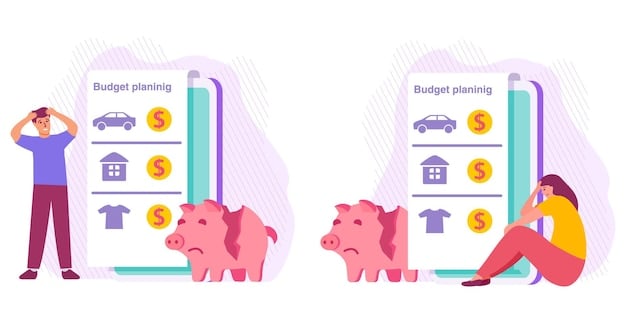Retirement Planning on a Budget: Secure Your Future

Retirement planning on a budget involves starting early with savings, making informed investment choices, reducing debt, and adjusting your lifestyle to ensure long-term financial security.
Planning for retirement can seem daunting, especially when you’re managing a tight budget. However, with a little planning and discipline, achieving a comfortable retirement is possible. This article explores how to start retirement planning on a budget, ensuring you secure your future without breaking the bank.
Start saving early: the power of compounding
One of the most effective strategies for retirement planning on a budget is to start saving as early as possible. The earlier you begin, the more time your investments have to grow through the power of compounding. Compounding allows you to earn returns not only on your initial investment but also on the accumulated interest.
Even small amounts saved consistently can make a significant difference over the long term. For instance, contributing just a few dollars each day can accumulate into a substantial sum over several decades. This approach is particularly beneficial when you’re working with a limited budget.
The impact of early savings
Starting early in retirement saving harnesses the advantage of having more time in the market. The more time your money is invested, the more time it has to grow exponentially. Even if you’re starting small, the benefits of compound interest can significantly enhance your retirement savings.
How to start saving early
Begin by setting realistic and achievable savings goals. Assess your current financial situation and determine how much you can comfortably set aside each month. Consider automating your savings by setting up regular transfers from your checking account to your retirement savings account. Even if it’s a small amount, the consistency will pay off over time.
- Automate savings: Set up automatic transfers to your retirement account each month.
- Start small: Even small contributions add up over time due to compounding.
- Be consistent: Regular contributions are more important than the amount.

Starting early and taking advantage of compounding is the keystone to successful retirement planning on a budget. Small, consistent contributions made early in your career can grow into a substantial nest egg over time, ensuring a more secure financial future. By automating savings and setting realistic goals, you can pave the way for a comfortable retirement without straining your current budget.
Maximize employer-sponsored retirement plans
Employer-sponsored retirement plans, such as 401(k)s, are a valuable tool for retirement savings. These plans often come with employer matching contributions, offering free money that can significantly boost your savings. By maximizing your contributions to these plans, you can take full advantage of this benefit.
Contributing at least enough to receive the full employer match can substantially increase your retirement funds without requiring additional sacrifices from your personal budget. This is an essential step in effective retirement planning.
Understanding employer matching
Many employers offer matching contributions, which means they will match a certain percentage of your contributions up to a specific limit. This is essentially free money that can accelerate your savings significantly. Make sure you understand the details of your employer’s matching policy to take full advantage of it.
Benefits of 401(k)s
401(k) plans offer several advantages, including tax-deferred growth, which means you don’t pay taxes on the earnings until you withdraw them in retirement. Additionally, contributions are often made pre-tax, reducing your current taxable income.
- Tax benefits: Contributions may be tax-deductible, and earnings grow tax-deferred.
- Employer matching: Many employers offer matching contributions, boosting your savings.
- Convenience: Contributions are automatically deducted from your paycheck.
Maximizing employer-sponsored retirement plans is a smart approach to retirement planning on a budget. By contributing enough to receive the full employer match and leveraging the tax benefits, you can substantially increase your retirement savings. This strategy ensures you’re making the most of available resources to secure your financial future without overextending your budget.
Explore low-cost investment options
Investing in low-cost options is critical to maximizing your retirement savings while minimizing expenses. High fees can erode your returns over time, so selecting investments with lower costs puts more money in your pocket over the long term. Index funds and ETFs can offer broad market exposure at a fraction of the cost of actively managed funds.
By choosing low-cost investment alternatives, you can improve your overall returns and reach your retirement goals faster. Keeping investment fees minimized helps you retain more of what your investments earn.
Index funds and ETFs
Index funds are designed to match the performance of a specific market index, such as the S&P 500. These funds typically have very low expense ratios because they passively track an index rather than requiring active management. ETFs (Exchange-Traded Funds) are similar to index funds but trade like stocks, offering greater flexibility.
Benefits of low-cost investing
Low-cost investing can significantly improve your long-term returns by minimizing the impact of fees. Over time, even small differences in expense ratios can add up to substantial savings. This strategy allows more of your money to work for you rather than paying for management fees.
- Lower fees: Index funds and ETFs have significantly lower expense ratios than actively managed funds.
- Diversification: These options offer broad market exposure, reducing risk.
- Long-term growth: Maximizing returns through low-cost options can substantially increase your retirement savings.
Exploring low-cost investment options is an intelligent strategy for retirement planning on a budget. By selecting index funds and ETFs with minimal expense ratios, you can reduce fees and maximize your returns over the long term. This approach ensures that more of your money stays invested, helping you achieve your retirement goals more efficiently.
Reduce debt to free up savings
Reducing debt is a cornerstone of effective retirement planning, especially when working with a budget. High-interest debt, such as credit card balances, can drain your financial resources and hinder your ability to save for retirement. By actively reducing your debt, you’ll free up more funds that can be directed towards your retirement savings.
Prioritizing debt repayment not only eases your current financial burden but also creates more space in your budget for saving and investing. This helps you build financial security for the long-term.
Prioritize high-interest debt
Focus on paying off high-interest debt first, as it can be the most costly. Credit card debt, in particular, often carries high interest rates that can quickly accumulate. Consider strategies such as balance transfers or debt consolidation to lower your interest rates and accelerate repayment.
Debt reduction strategies
Develop a debt repayment plan that fits your budget and financial goals. The snowball method involves paying off the smallest debts first to gain momentum, while the avalanche method prioritizes debts with the highest interest rates. Choose the method that best suits your preferences and stick to it consistently.
- Snowball method: Pay off smallest debts first for quick wins.
- Avalanche method: Target debts with the highest interest rates first.
- Balance transfers: Move high-interest debt to a lower-rate card.

Reducing debt is a critical step in retirement planning on a budget. By prioritizing high-interest debt repayment and implementing effective debt reduction strategies, you can free up funds that can be redirected towards retirement savings. This approach not only alleviates current financial stress but also enhances your ability to build a secure financial future.
Adjust your lifestyle and spending habits
Adjusting your lifestyle and spending habits plays a pivotal role in successful retirement planning on a budget. Identifying areas where you can cut back on expenses can create extra funds for savings. Small changes, such as cooking at home more often, reducing discretionary spending, and finding affordable entertainment options, can add up over time.
Making conscious choices about how you spend your money can significantly impact your ability to save for retirement. It’s about aligning your lifestyle with your financial goals so that long-term security is prioritized.
Identifying areas for savings
Review your monthly expenses to identify areas where you can reduce spending. Look for non-essential items or services that you can cut back on or eliminate altogether. Consider setting a budget and tracking your spending to ensure you stay on track.
Making small changes
Small changes in your daily habits can have a big impact on your savings. Bringing lunch to work, brewing coffee at home, and reducing entertainment expenses are simple ways to save money without drastically altering your lifestyle.
- Budgeting: Create a budget to track and manage your spending.
- Cooking at home: Reduce dining out expenses by cooking more meals at home.
- Cutting discretionary spending: Identify and reduce non-essential expenses.
Adjusting your lifestyle and spending habits is an essential component of retirement planning on a budget. By identifying areas for savings, making small changes in your daily routine, and aligning your spending with your financial goals, you can free up funds for retirement savings. These mindful adjustments can significantly enhance your ability to secure a comfortable retirement.
Seek professional financial advice
Seeking professional financial advice is a prudent step in retirement planning, especially if you’re working with a budget. A qualified financial advisor can provide personalized guidance based on your unique financial situation and goals. They can help you navigate complex investment decisions, develop a comprehensive retirement plan, and ensure you’re making informed choices.
Professional advice can provide clarity and confidence in your retirement planning process, ultimately helping you reach your financial goals more efficiently and effectively.
Benefits of a financial advisor
A financial advisor can help you assess your risk tolerance, develop an investment strategy, and manage your portfolio. They can also provide guidance on retirement planning, tax optimization, and estate planning.
Questions to ask an advisor
Before hiring a financial advisor, ask about their fees, qualifications, and experience. Understand their approach to investing and ensure they are a good fit for your needs and goals. Common questions include how they are compensated, what services they provide, and their track record.
- Fees: Understand how the advisor is compensated (e.g., fee-based, commission-based).
- Qualifications: Verify their credentials and experience.
- Investment approach: Determine if their investment philosophy aligns with your goals.
Seeking professional financial advice is a valuable resource in retirement planning on a budget. A qualified financial advisor can offer personalized guidance and support, helping you make informed decisions and develop a comprehensive retirement plan. This expertise can significantly enhance your ability to reach your financial goals and secure a comfortable retirement.
| Key Point | Brief Description |
|---|---|
| ⏳ Start Early | Begin saving as early as possible to maximize compounding. |
| 🏢 Maximize 401(k) | Take full advantage of employer matching contributions. |
| 📉 Low-Cost Investments | Choose index funds and ETFs to minimize fees. |
| 💳 Reduce Debt | Pay off high-interest debt to free up more savings. |
Frequently Asked Questions (FAQ)
▼
A common guideline is to save 15% of your income for retirement, but this can vary based on your lifestyle and goals. Consulting a financial advisor can provide a more tailored recommendation.
▼
Index funds and Exchange-Traded Funds (ETFs) are popular low-cost options. These investments typically have lower expense ratios, maximizing your returns over the long term.
▼
Prioritize paying off high-interest debt, such as credit card balances. Strategies include the snowball method and the avalanche method. Consider balance transfers for lower interest rates.
▼
Employer matching is when your employer matches a certain percentage of your contributions to your 401(k) up to a specific limit. It’s essentially free money that boosts your retirement savings.
▼
Yes, a financial advisor can provide personalized guidance based on your situation. They can help you navigate complex decisions, develop a plan, and ensure you’re making informed choices.
Conclusion
Retirement planning on a budget is achievable with the right strategies and a disciplined approach. By starting early, maximizing employer-sponsored plans, exploring low-cost investments, reducing debt, adjusting lifestyle habits, and seeking professional advice, you can secure a comfortable retirement without straining your current finances.





